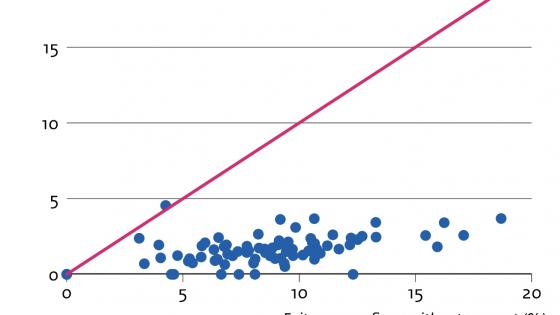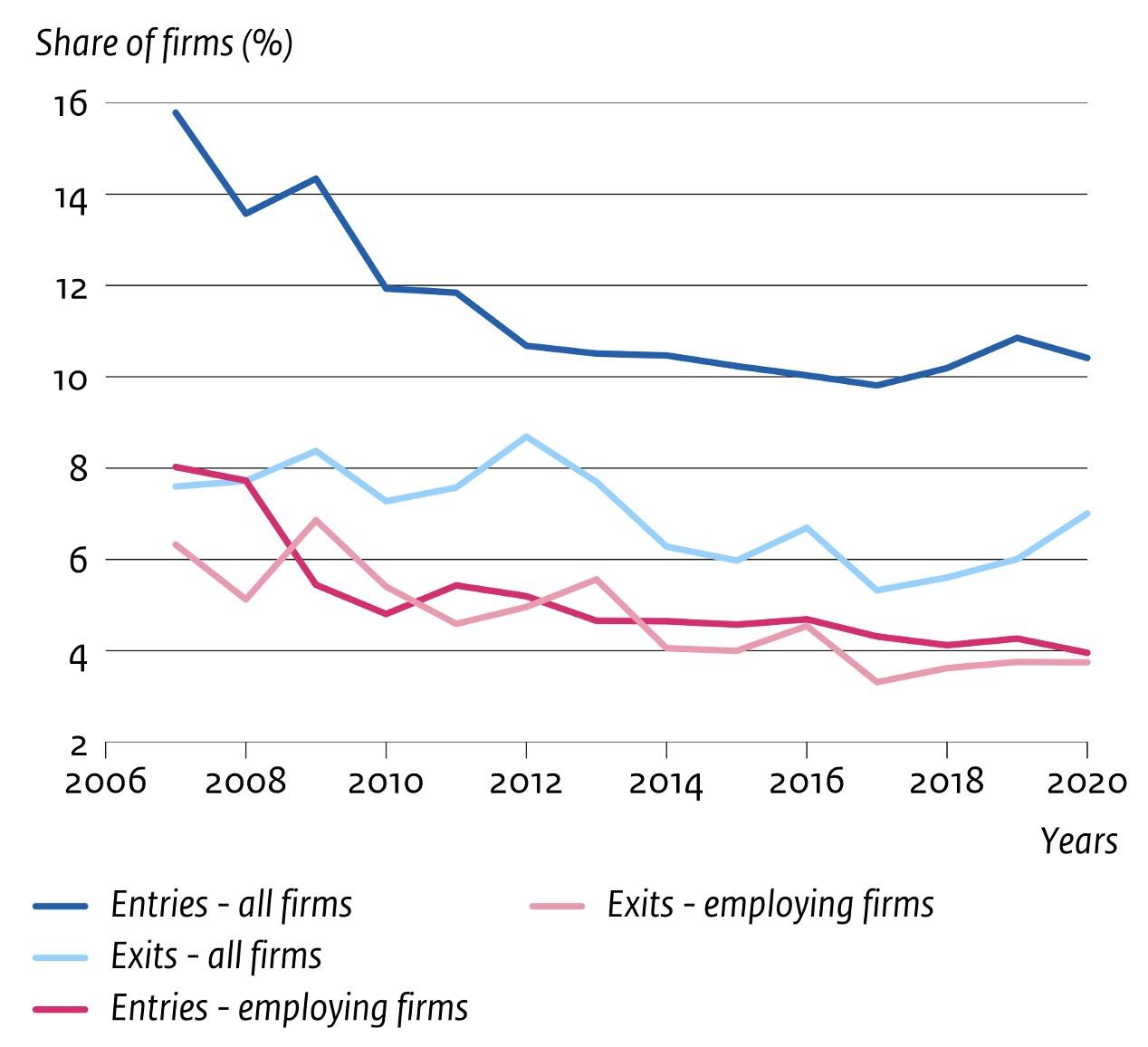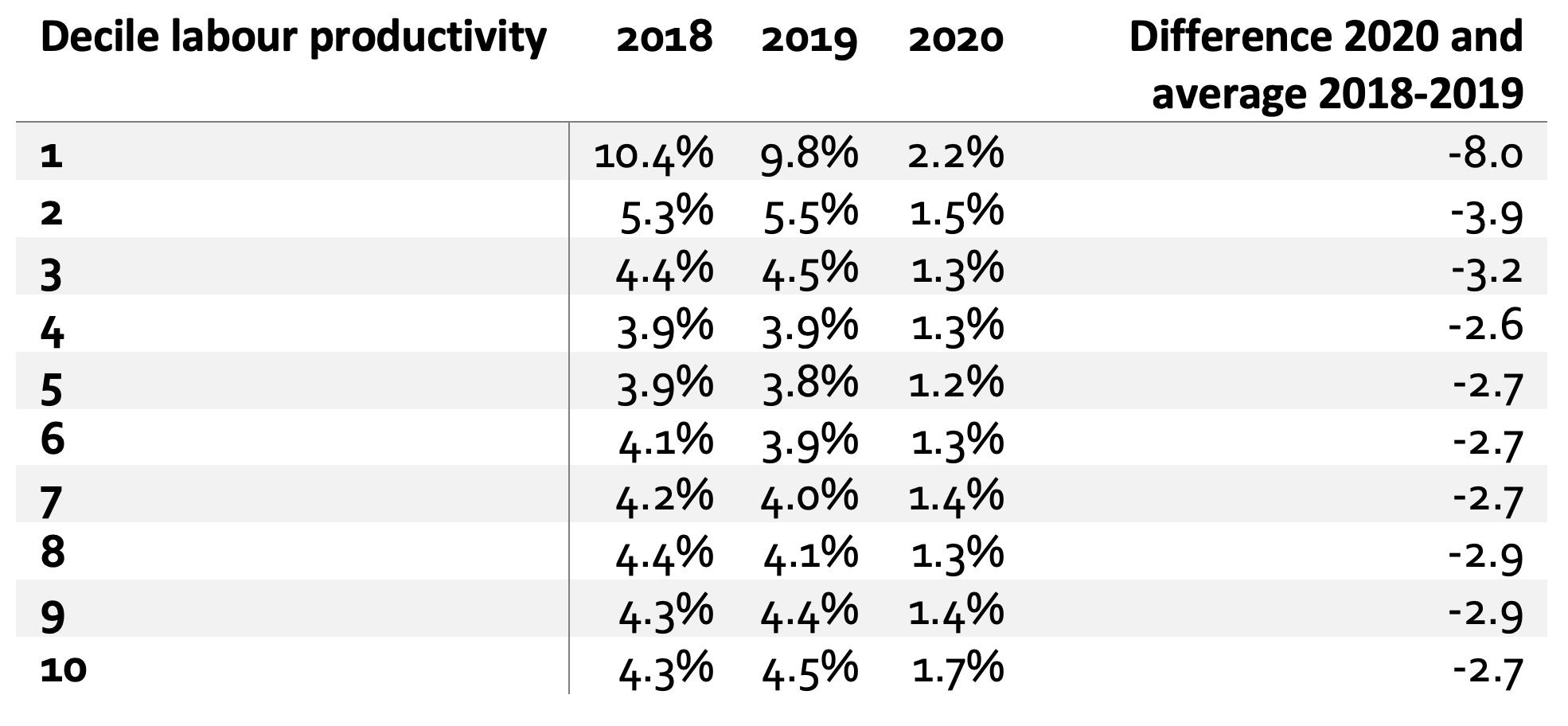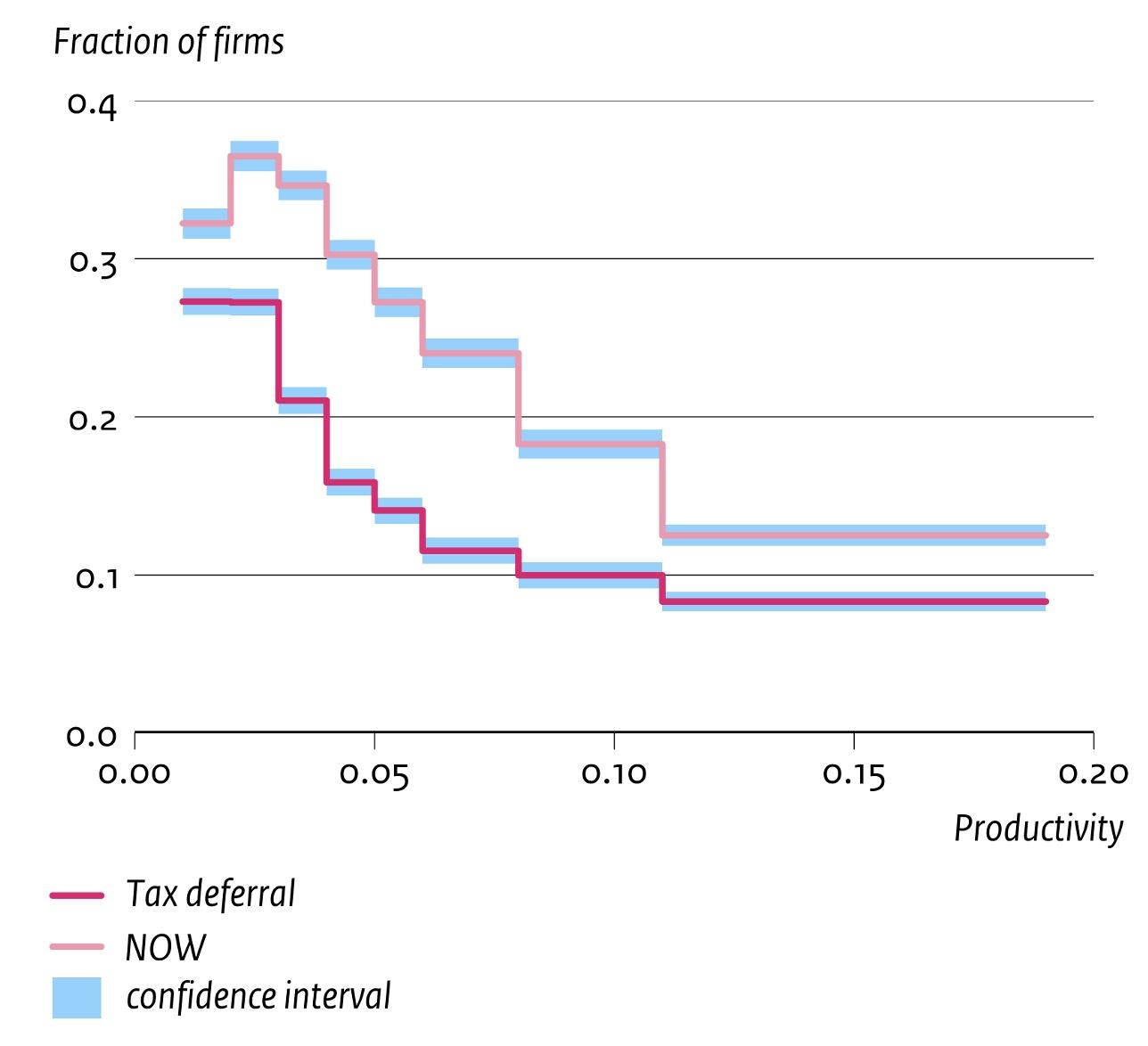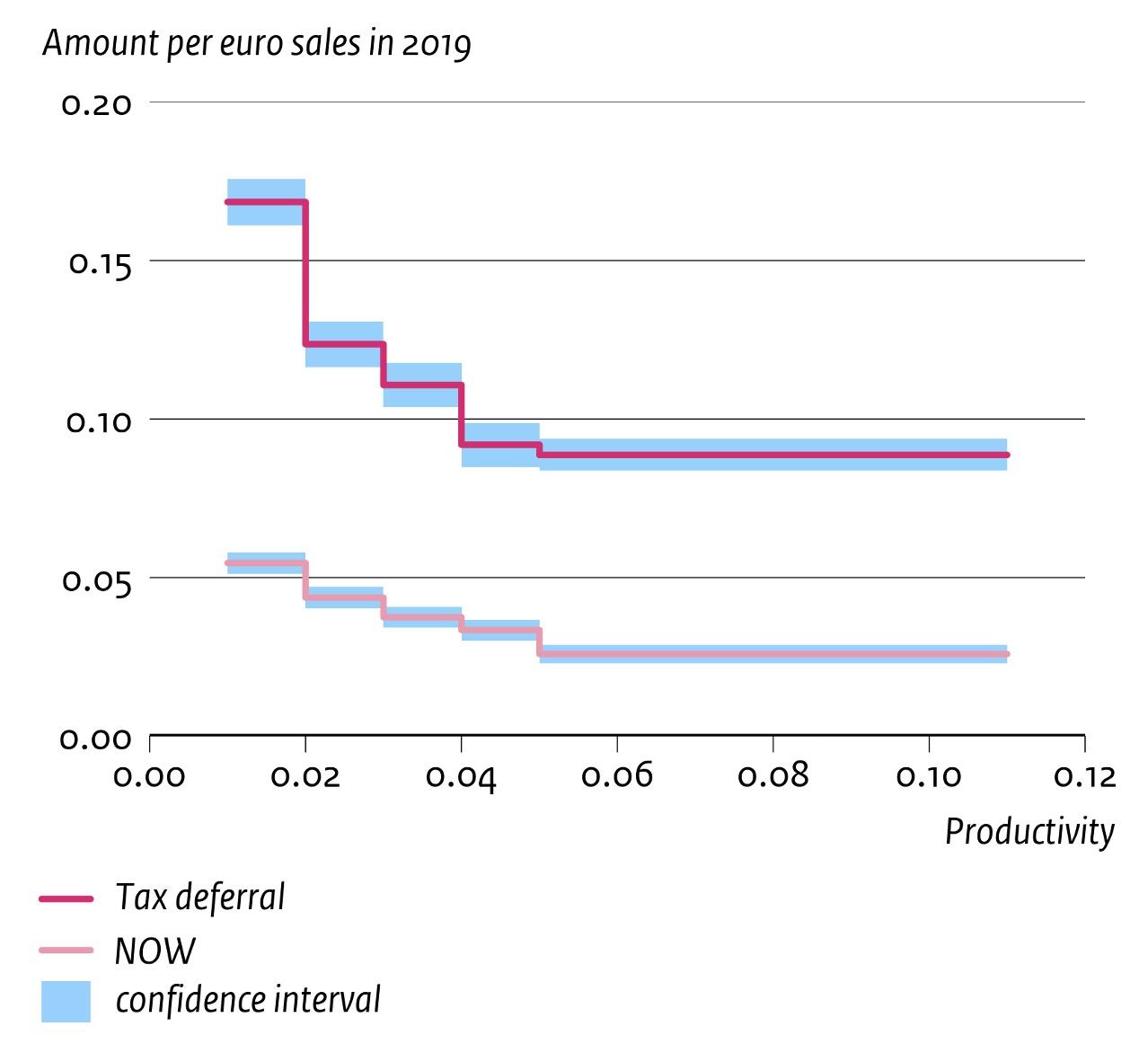As in most other countries, the government in the Netherlands has implemented generous support measures for firms during the Covid-19 crisis, aiming to prevent unnecessary bankruptcies and protect jobs. The extensive support packages run the risk of harming future productivity growth due to reduced creative destruction, i.e. the cleansing of the least productive firms in the economy in the competitive process. This risk is positively related to the generosity of the support and the length of the support period.
Evidence for France records creative destruction has not been distorted throughout 2020 (Cros et al. 2021) and that support has been evenly distributed across firms of different productivities (Bénassy-Quéré et al. 2021). Bighelli et al. (2021) show support has impacted productivity positively by flowing disproportionally to high productivity firms in several other EU countries, mirroring the French results.
In contrast, while successful at keeping firms afloat, government support in the Netherlands disrupted creative destruction. Like in many other countries, the number of bankruptcies was historically low in 2020. We find the exit rate was considerably lower among supported firms than for those that were not supported. At the same time, low productivity firms have received support more often and more generously (relative to their size). Consequently, we observe that the exit rate declined the most for firms with the lowest productivity.
We focus on the two largest (by expense) support measures. This first, wage cost subsidies (NOW) rounds 1, 2, and 3, was available to all firms with employees that expected Covid-19-related revenue losses of at least 20%. The second, tax deferral was open to all firms with very few prerequisites and allowed them to postpone most of their tax payments. Take-up for firms with employees was roughly 27% for NOW and 55% for tax deferral (CBS 2021). Some of the NOW advances (if realised revenues are higher than expected) and all of the tax deferrals will have to be paid back in the future. We use data from balance sheets of all non-financial corporations in 2019 and link these to their use of support measures in 2020.1
Firm dynamics in 2020
Dutch business dynamics in 2020 stand in stark contrast to the 2008-2009 recession, when dynamics reacted strongly to the economic turmoil (see Figure 1). Entries and exits in 2020 changed little compared to 2019, particularly for larger firms. Additionally, Figure 2 shows the number of bankruptcies (subset of exits) decreased strongly during 2020 (Overvest and Fareed 2021).2
Figure 1 Firm dynamics relatively stable in 2020
Figure 2 The number of bankruptcies declined strongly
Furthermore, the share of exits is much lower for supported firms than for unsupported firms. Figure 3 shows, per industry, the share of exits among unsupported (horizontal axis) and supported firms (vertical axis). Virtually all points are well below the 45-degree line, indicating the exit rate of supported firms is considerably lower than that of unsupported firms.
Figure 3 Supported firms exit less than unsupported firms
The exit rate among unsupported firms was highest in industries hardest hit by the lockdown, found towards the far right-hand side of Figure 3. These industries include sports and recreation, hospitality, and casinos. In these industries the exit rate among unsupported firms was more than 15%; for supported firms, it was less than 5%.
Dynamics and productivity
Replacing low-productivity firms with new, highly productive firms is an important driver of productivity growth and the mechanism behind creative destruction (Freeman et al. 2021). Table 1 shows the exit rate per decile of the distribution of labour productivity, which is calculated as value added per hour worked. In accordance with creative destruction, the percentage of exits in the lowest productivity decile in 2018 and 2019 was substantially higher (at about 10%) than for the rest of the distribution (4-5%).
In 2020, the share of exits was lower for all groups. However, it fell most for the lowest productivity firms: by eight percentage points compared to the two to four percentage points for the other groups. This suggests that the creative destruction dynamic was disrupted in 2020. This finding holds not just on aggregate but also within industries.
Table 1 Percentage of exits per year per productivity decile, all non-financial corporations
Source: Own calculations based on CBS microdata.
Support and labour productivity
We zoom in on two components using a panel regression: first, we relate the productivity distribution to the share of supported firms; second, we relate it to the support-amounts scaled by revenue in 2019. The two components result from interactions with ten and five group dummies, which cover the productivity distribution. Fixed effects are included to control for industry differences. This means that the results are not driven by industry-specific differences in support take-up.
Figure 4 Low productive firms received support more often
Figure 5 Low productive firms received more support
For both support measures, Figure 4 shows firms with the lowest productivity received support most often, with the share of firms receiving support rapidly dropping for higher productivity deciles (each horizontal segment presents 10% of all firms). Similarly, Figure 5 shows low-productivity firms received the highest amount of support relative to their revenue in 2019. This is presented for five groups (quintiles) instead of deciles, as it is restricted to supported firms only.
Recall the pattern we see in Table 1: a notable lower exit rate in 2020, particularly for the least productive firms. This fits with the observation that firms in low-productivity groups received support more often and received more support. Combining these findings suggests that low-productivity firms have been kept alive disproportionately by government support.
Conclusion
The main objective of the support policy has been achieved: firms, and with them jobs, have been preserved through the Covid-19 crisis. The government support measures had to be quick and simple, contain few conditions, and have low implementation costs. At the same time, we find that the support ended up disproportionally with less-productive firms. As a result, these firms survived longer than might have been expected based on pre-2020 patterns of exits.
This disruption of the dynamics did not occur in other countries (Bighelli et al. 2021, Cros et al. 2021). This raises the question of why the Dutch government’s support during Covid-19 appears to have impacted firm dynamics more adversely than elsewhere. Perhaps the support measures were more widely and readily available. Qualification for NOW support was easy, starting at a low expected revenue-loss cut-off, and many recipients were overly pessimistic about their drop in revenues and received too much in advances (Schellekens et al. 2021), while tax deferral had no cut-off at all. Of course, the ubiquity of Dutch support measures might have limited other adverse Covid-19-related impact, such as job losses.
Finally, the results reflect the situation in 2020. Current data do not allow us to say how the dynamics will be affected by the phasing out of support measures, which commenced in late 2021. It is possible that some firms have been propped up by support and will fail once it stops. Moreover, firms will have to pay back some or all of the support received. This might lead to a stronger process of creative destruction in the near future. The speed of the phasing out phase will play an important role in this development (Overvest and Smid 2021).
References
Barnes, M, L Bauer, and W Edelberg (2021), "11 facts on the economic recovery from the COVID-19 pandemic", The Hamilton Project, Brookings.
Bénassy-Quéré, A, B Hadjibeyli, and G Roulleau (2021), "French firms through the COVID storm: Evidence from firm-level data", VoxEU.org, 27 April.
Bighelli, T, T Lalinsky, and F di Mauro (2021), "Covid-19 government support may have not been as unproductively distributed as feared", VoxEU, 19 August.
CBS (2021), "Gebruik van steunmaatregelen corona per 31 december", Statistics Netherlands.
Cros, M, A Epaulard, and P Martin (2021), "Will Schumpeter catch Covid-19?", CEPR Discussion Paper No. 15834.
Freeman, D, L Bettendorf, G H van Heuvelen, and G Meijerink (2021), "The contribution of business dynamics to productivity growth in the Netherlands", CPB discussion paper.
Overvest, B and F Fareed (2021), "Business dynamics during the COVID pandemic", CPB Netherlands Bureau for Economic Policy Analysis.
Overvest, B and B Smid (2021), "Balansherstel bedrijven na corona", CPB Netherlands Bureau for Economic Policy Analysis.
Schellekens, M, A L Cnossen, and R ’t Jong (2021), "Terugvordering coronasteun wordt miljardenoperatie", ESB.
Endnotes
1 The data on support measures relate to the state of affairs up to and including 31 December 2020. The amounts we show therefore consist of advances or payment deferrals and not necessarily definitive payments.
2 Evidence for other countries suggests similar reductions in, particularly, exits (Barnes et al. 2021).
